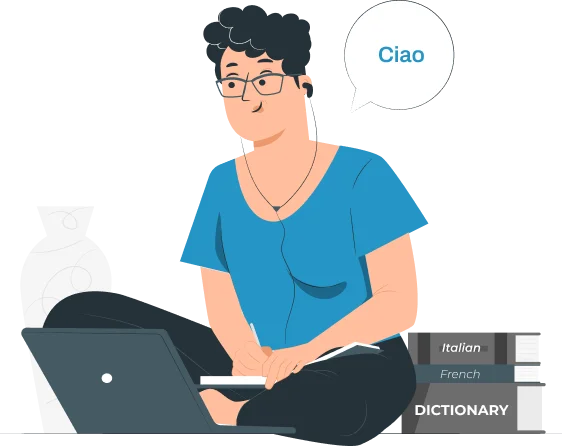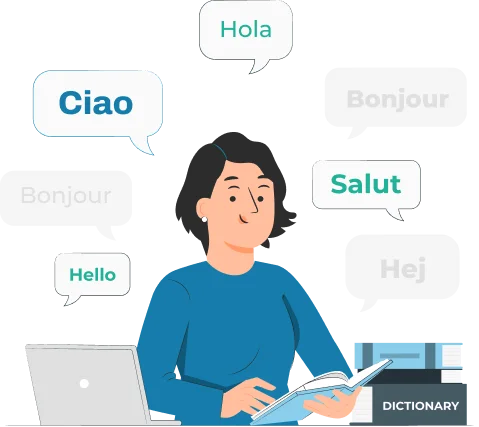
Italian Language With 85 Million Global Speakers
Italian is the official language of 93% of the people of Italy and the language of Vatican City. The Italian language is the 21st most spoken international language. Italian population accumulates to 58.8 million people. Interestingly, the Italian language is not limited to its borders, it is also the official and co-official language of many countries, including Switzerland (1.2 million speakers), Albania (800,000), USA (3.8 million), and Slovenia (250,000). The Italian language speakers include 65 million native and 20 million non-native speakers. Among the different dialects of Italian languages, the “South Italian” dialect is the most popular. Italian is the 15th most spoken language in the US. So, if your company/business is looking to go beyond the local market, our best Italian translation services will give you an ideal jumpstart.
Improve ROI By Acquiring Italian To English Translation Services
There are 1.5 billion English speakers worldwide. While launching and expanding international marketing campaigns for products or services, the need and demand for Italian to English translations are increasing exponentially. According to statistics, English is the official language of 86 different countries and 39% of the countries have English as one of their official languages. This means all their business activities are conducted in English and they need professional Italian translation services to reach Italian audiences. Businesses want nothing more than a professional approach to reach global markets. If you’re also interested in taking your Italian business or brand to English markets, you must be aware of the various vocabulary, idiomatic expressions, colloquial jargon, cultural differences, and references that make Italian different from English.

We translate all kinds of Italian documents
Need to translate Italian documents? You’re at the right place. CCJK is fully equipped with industry-leading expertise and modern technology to deliver professional Italian translation services.
Technical translations into Italian
Italian medical translation services
Website translation into Italian
Italian legal translations
Technical translations into Italian
As with other languages, the technical vocabulary of Italian is confusing enough to translate and verbalize while maintaining the original idea, context, and tone. Major businesses and brands are now acquiring professional Italian translation services to ensure the quality of translations. CCJK has been providing its industry-leading Italian translation services for two decades. Get CCJK’s Italian translation services for your required documents today and you will surely appreciate the linguistic fluency and cultural precision of your Italian translations.
Italian medical translation services
Medical science is evolving at the speed of light. Businesses, brands, and companies are expected to keep up with the modern advancements in medications and diagnostic procedures to stay afloat and relevant to the market trends. Crystal-clear communication of information plays an essential and life-saving role in medical translations. CCJK is always proud to help facilitate this information exchange process by providing medical translation services in Italian and other languages. Our Italian medical translators have advanced degrees in medical, pharmaceutical, and other healthcare fields.
Website translation into Italian
Website translation is not just changing words, it’s a professional practice of localization and helps bridge language and cultural differences in the globalization of your brands and businesses. Here at CCJK, we always enlist industry specialist native Italians who can translate and localize your website according to the required Italian dialects. Whether you want to translate a page or an entire site, we always welcome you for projects of any size and deliver within the required timeframe. Just remember that it’s never too late to make your online businesses multilingual with professional website translation services.
Italian legal translations
CCJK is an industry-leading name in legal translation services from English to Italian and Italian to English. Furthermore, we offer 800 other language pairs. Our satisfied customer base includes individuals, law firms, financial companies, as well as brands and retailers in many sectors. These clients trust our modern Italian translation services in areas such as law regulations, intellectual property, tax, insurance, immigration, technology, and more. Our trademark due diligence enables us to keep your information secure and intact, saving you from unnecessary delays and complexities.
Start Your Italian Translation Now.
Meet our native Italian translators
In our network of 30,000+ language experts, we’ve many native-speaking Italian translators who know the language inside out. They know how Italian is used in different parts of the world and are fluent in all dialects. When you want to hire our Italian translation services, we’ll connect you with professionals who translate your documents by focusing on a specific dialect according to your target market.
Language support
Italian translation services in 230 languages
A top provider of Italian translation services, CCJK allows you to choose between 230 language options to get your documents translated into Italian or from Italian to other languages.
